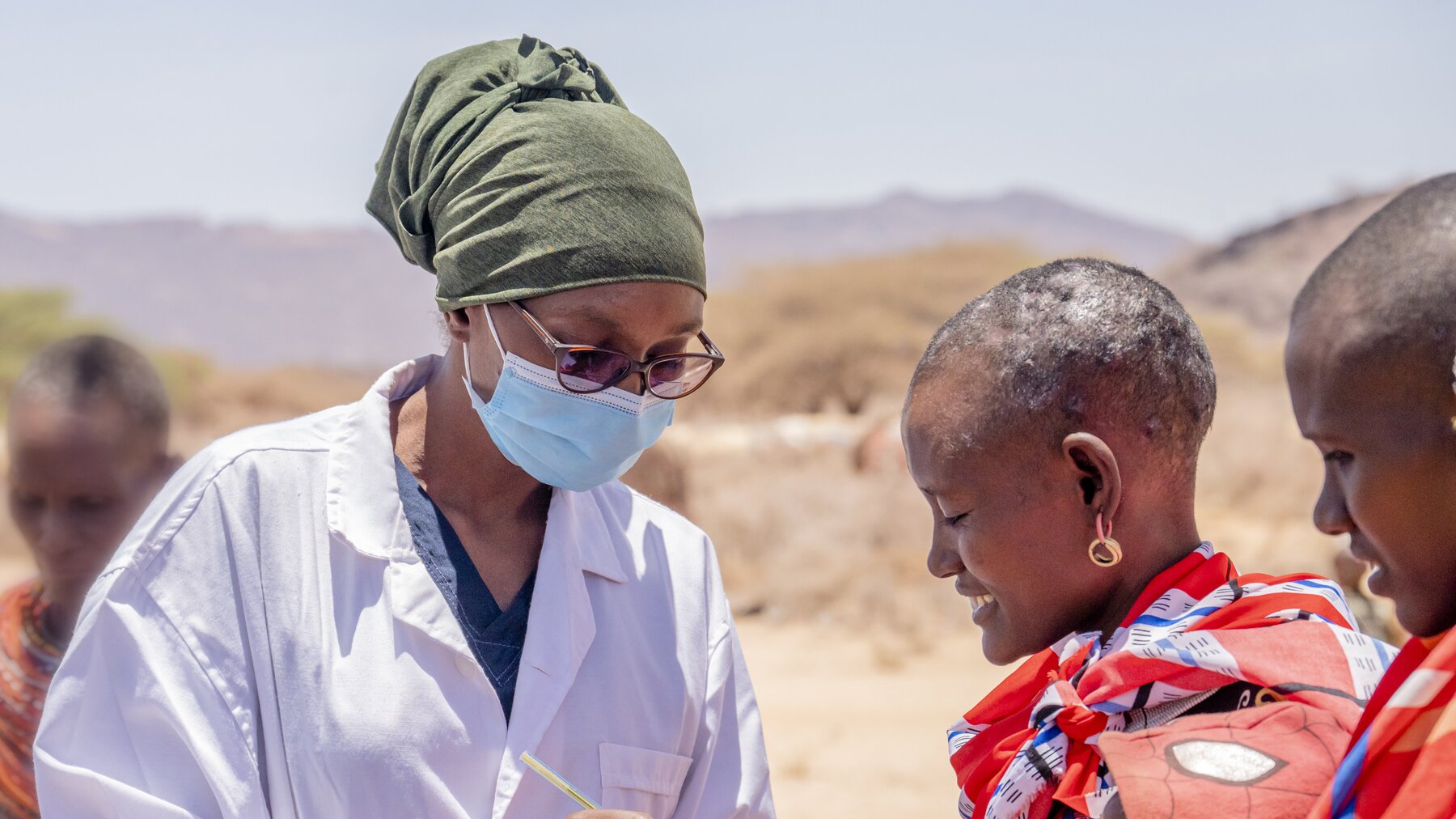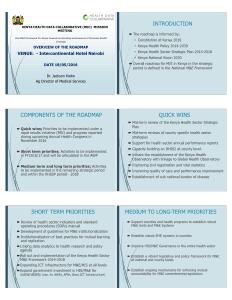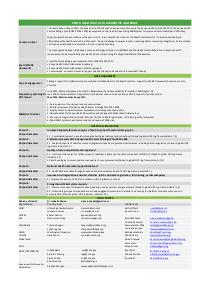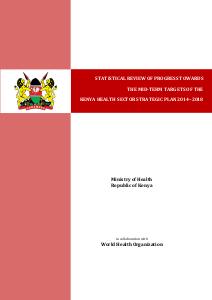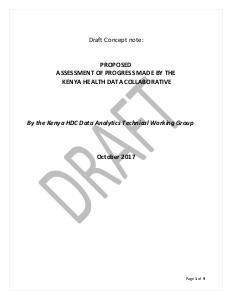Kenya
Overview

The Ministry of Health of Kenya is committed to supporting global efforts to increase accountability and improve quality data for decision-making. A team from the Ministry of Health, led by Dr. Isabella Maina, head of the M&E Unit, participated in the Summit on Measurement and Accountability for Results in Health in June 2015. At the Summit, more than 600 global health leaders, decision-makers, thought leaders and implementers from 60 countries representing development partners, partner country governments, and civil society endorsed the Roadmap for Health Measurement and Accountability and Five-Point Call to Action.
Progress
Since Kenya’s Ministry of Health launched the Kenya Health Data Collaborative in May 2016, a mid-term review of the Kenya Health Sector Strategic Plan, a series of data analytics capacity building workshops, and workshops across 33 counties to strengthen civil registration and vital statistics (CRVS) have all been successfully completed with the support of HDC partners.
A mapping of health information systems and M&E investments, supported by USAID, WHO and UNICEF, was also published in October 2017 and is informing the development of a common investment framework. Additionally, the Ministry of Health brought together partners and aligned funding for four separately planned health facility surveys (on client satisfaction, employee satisfaction, data quality, and service readiness), which were combined into one survey. A review of progress made by the Kenya HDC has found that significant progress has been made on partner alignment, though this varies by partner, and some priority areas remain unfunded while others are overfunded.
Key HIS/M&E documents developed by the country include:
- Health Sector Strategic and Investment Plan (KHSSP) 2013-2017
- Kenya Health Data Collaborative Roadmap
- Kenya Health Data Collaborative Conference Report
- Communiqué on commitments to support One Monitoring and Evaluation Framework for Kenya
- Mid-Term Review of Kenya Health Sector Strategic Plan
- Resource Mapping for Health Information and Monitoring and Evaluation Systems
Kenya Ministry of Health Data and Digital Priorities 2021
Key priorities
Heath Data Collaborative partners are working alongside the Ministry of Health of Kenya following a request for collective action to strengthen country data and accountability systems. Identified priorities are as follows, more details on the priorities are available here:
Building data analytics capacity at the national and sub-national levels
Mid-term review of the Kenya Health Sector Strategic Plan (2014-2018) and its Monitoring & Evaluation Plan
Quality of care and performance improvement
Operationalizing a Kenya health observatory
Improving Civil Registration and Vital Statistics (CRVS)
Rapid Monitoring and Evaluation system capacity assessment
Key documents
Activities & milestones
August 2018
Ministry of Health Plans Harmonized Health Facility Assessment
Availability of comprehensive information on service availability and readiness of facilities to offer quality health services is key in informing policies to achieve Universal Health Coverage. For this reason, the Ministry of Health together with development partners and counties has planned to carry out a Harmonized Health Facility Assessment (HHFA). This assessment will bridge the gaps previously addressed by the Service Availability and Readiness Assessment Mapping (SARAM) and Service Provision Assessment (SPA), among other surveys. This follows closely on the Health Data Collaborative principle of harmonizing technical and financial resources in the implementation of health information initiatives. The following are relevant documents:
- Invitation from Ministry of Health on workshops to harmonize the assessment tools
- Implementation plan for the Kenya Harmonized Health Facility Assessment
- Agenda for first HHFA tools review workshop
- Presentation on Kenya harmonized health facility assessment for UHC
- Flyer on Standardized Health Facility Survey Modules
March 2018
Ministry of Health and Partners Conduct Review of Kenya HDC
Two years after the launch of the Kenya Health Data Collaborative (KHDC) the Ministry of Health and its partners agreed to review progress towards the overall goal of one well-functioning country-led health information system. Representatives of 16 of the 47 counties, partners and Ministry of Health staff participated in a workshop in March 2018 to gather their views on HDC implementation at national and sub-national levels.
Key findings were as follows:
- Alignment of partners varies considerably between programmes and counties.
- The governance structure of the KHDC needs to be re-visited to improve partner coordination at national and county levels.
- Funding should be available for the Ministry of Health for HDC coordination in its early stages.
- Sub-national support for county-level M&E systems is a priority, particularly to build capacity for analysis and use of data.
- Establishing a baseline when a country-level HDC is launched is essential for effective monitoring of progress.
December 2017
Ministry of Health Prepares Year 2 Work-Plan for Kenya HDC
The Year 2 work-plan for the Kenya HDC will be finalized in January 2018. An evaluation of the Kenya HDC is to start in March 2018 to assess progress made since the Kenya HDC was launched in May 2016. The review will include three components: 1) a review of the actions undertaken by government and partners to achieve the quick wins of the KHDC roadmap; 2) a review of the partner investments and actions to achieve the priorities of the KHDC through key informant interviews; and 3) a review of M&E practices and needs of a sample of counties. For more details, please see the draft Concept Note. An investment plan for M&E will also be developed with support from partners including the World Bank and WHO, based on a HIS/M&E resource mapping report that details government and partner investments in HIS/M&E. Separately, the MoH is planning to conduct a harmonized health facility survey in January.
October 2017
Ministry of Health Publishes Resource Mapping Report
Achievement of the Kenya HDC's objective of rallying all stakeholders in Kenya’s health sector to one Monitoring and Evaluation (M&E) framework that enjoys full support and implementation by all actors in health is intertwined with the need for partners to align their technical and financial commitments around strong, nationally owned HIS and a common M&E plan. Thus, one of the quick wins recommended for implementation was the comprehensive mapping of partner support to Health Information System (HIS)/M&E activities in the health sector.
In accordance with this recommendation, a partner resource mapping activity was initiated in August 2016. The goal of the mapping exercise was to estimate existing resources for Kenya’s HIS from all sector stakeholders. This information would allow for more informed and efficient investments in HIS in the future. Resource mapping was also intended to help identify gaps and potential duplicative investments at the national and county levels, providing stakeholders with the evidence necessary to inform modification of their future investments according to the priorities set out in Kenya’s health plans and especially in the M&E plan. Once completed, resource mapping would inform the development of a multi-year, multi-stakeholder investment plan for M&E that would align technical and financial assistance with country-defined priorities, reduce fragmentation and duplication of efforts, and lower the burden of reporting, resulting in more efficient and aligned investments in M&E.
Full results from the resource mapping can be viewed here.
September 2017
Ministry of Health Plans Review of Kenya HDC Approach
To reflect on the first year since the Kenya HDC launch in May 2016 and as part of a learning agenda to be shared with other countries, an external evaluation of the HDC approach in Kenya is planned for the beginning of 2018. This evaluation will also inform future implementation of activities, as well as guide other countries who wish to adopt the HDC approach. A concept note has been drafted to start the planning process.
June 2017
Data Quality Review Training Workshop Conducted
Kenya's Ministry of Health conducted a workshop on assessing data quality to improve the reliability and use of the national health information system by all stakeholders. The workshop was attended by more than 40 participants from the Ministry of Health, UNICEF, Jomo Kenyatta University, Global Fund, and the Health and Economics Finance Development Consortium (HEFDC). A follow-up training of trainers is required to roll out the program to staff of Kenya’s 47 counties. Training on analysis and synthesis of health data is also needed to support both the annual health sector review and development of the new strategic plan.
June 2017
Kenya HDC Partners Collaborate on National Health Observatory
Kenya’s Ministry of Health is developing a Kenya Health Observatory (KHO) to improve the availability and use of health information. The observatory is planned to be an open-access one-stop-shop for data and statistics, including research data, and will facilitate active tracking of the state and determinants of health in the country. This is one of the six priorities identified by the Ministry of Health when it launched the Kenya Health Data Collaborative in May 2016.
Key findings from the midterm review of the Kenya Health Sector Strategic Plan 2014-2018 (produced in November 2016) provide the basis for the initial development of the observatory. A workshop was held on 10 June with 20 participants from Ministry of Health, University of Nairobi, The Kenya Medical Research Institute (KEMRI), World Bank, UNICEF, CDC, Intellisoft, African Institute for Development Policy (AFIDEP), and the WHO Country Office to advance the design and installation work. Many partners have committed to contribute health information products for the observatory, demonstrating alignment and buy-in toward the initiative. For example, UNICEF has committed to provide its Nutrition Dashboard, and KEMRI has agreed to share its research work on the observatory. Read more about the development of the KHO here.
April 2017
Health Data Investments in Kenya Mapped
Kenya’s Ministry of Health has drafted a report detailing 28 health partners’ investments (totaling $50 million) in health information systems and monitoring and evaluation (HIS/M&E) activities in the health sector. This mapping exercise (using a tool jointly developed by MoH, WHO, USAID, UNICEF and GIZ) aims to identify gaps and duplication in investments and will inform a common investment framework for partners, aligned with country-defined priorities in HIS/M&E. For example, a majority of partners are supporting health information policy, planning and monitoring, which suggests that a high level of coordination is needed to avoid duplication in this area. At the county level, Homa Bay is benefiting from the highest level of investment -- $2.2 million -- while seven counties are receiving no funds. Further investigation is needed to determine whether such disparities are justified.
February 2017
Partners Support County-Level Training on Birth and Death Registration Tools
Training on ICD10 (International Classification of Diseases) has been conducted in 5 counties (Isiolo, Nakuru, Migori, Murang’a, and Kisumu), with support from WHO and USAID’s Measure PIMA project. More advanced ICD implementation through monitoring, mentorships, and training in Analysis of Cause of Death (ANACOD) and performing checks on cause of death data (CoDEdit) have been conducted in 10 counties (Kilifi, Nairobi, Nakuru, Homabay, Kakamega, Siaya, Kisumu, Machakos, Murang’a, Migori), with support from USAID-PIMA. Training on the Verbal Autopsy tool was conducted in Racuinyo North sub-county, with support from CDC. UNFPA and USAID-PIMA have also completed a compilation and analysis report of vital statistics (KVSR 2015), which will soon be published.
January 2017
MoH Completes Mapping of Domestic and External Investments in Health Data
Using a tool developed jointly by UNICEF, USAID and WHO, the Ministry of Health worked with Unicef to conduct a mapping of all domestic and external investments in Kenya's health information systems. This information will support the development of a common investment framework for all health partners in the country. More than 85% of partners supporting HIS/M&E in the country submitted information using the mapping tool, and results will be presented at the National Health Congress. Preliminary analysis shows that 25 organizations are investing more than $40 million in health information systems, with about half being county-specific, a quarter going to the national level and the rest across all counties. This exercise will help identify any areas of duplication and ultimately encourage more aligned and efficient support through the common investment framework.
November-December 2016
Global Fund Re-Directs Financial Support to Meet Kenya HDC Priorities
Data analytics workshops in July-September revealed the need for more data collection through multiple health facility surveys. While the Global Fund had hired a consultancy firm to conduct a data quality review, based on the needs identified by the Kenya HDC, it decided to also support additional survey modules to assess client satisfaction, employee satisfaction and service availability and readiness (using an abbreviated SARA of sampled facilities). Technical assistance was also provided from WHO, Jomo Kenyatta University, CDC and USAID) in late November to collect data from 250 facilities in 19 counties.
Data collection was completed in early December and the ministry’s M&E team is currently cleaning the data for analysis use. Conducting a consolidated survey demonstrates an efficient use of resources and harmonization of partner activities – both core principles of the Health Data Collaborative approach.
October 2016
Key Findings Emerge from Kenya’s Mid-Term Review of Health Sector
One of the priorities of the Kenya Health Data Collaborative is to support data analysis activities for the mid-term review of the national Health Sector Strategic Plan (2014-2018). Since July, the health ministry has collaborated with partners on three data analytics workshops to generate the mid-term review report that will be presented at the National Health Congress. Some thematic headlines that will be highlighted:
- Improvements in reproductive, maternal and child health: number of women delivering in health facilities has increased to 72% in 2015/16 from 60% in 2013/14.
- Progress in the battle against major infectious diseases: use of anti-retroviral drugs among persons living with HIV has increased to 62% from 47%.
- Immunization coverage has declined in more than two-thirds of counties.
- Increase in the burden of non-communicable diseases: rate of obesity among women has increased to 13% in 2015 from 7% in 2009.
October 2016
USAID award granted to Palladium
Award to support work in health informatics, health data governance and learning and accountability.
October 2016
MoH launches activity mapping for Health Information Systems
The Activity Mapping exercise collates information on budgeted HIS/M&E investments from each development partner across each county and at the national level. Once completed, the information will help Identify gaps and potential duplicative investments at the national and county level, and ultimately, enable more informed and efficient investments in future budget cycles. In combination with the costing of priority HIS/M&E activities, the Activity Mapping will be the foundation for the common investment framework. Results from the Activity Mapping will be presented at the National Health Congress in November.
September 2016
MoH conducts third workshop for Mid-Term Review of Health Sector Strategic Plan
Data analytics workshops in July and August with partners were followed by a third workshop Sept. 19-23 to bring together members from the three streams of Mid-Term Review work (Data analytics, Analysis of finance and budgets, SWOT analysis of the health system) to interpret results and use for planning and policy. Field visits and interviews with key informants at the national and county level and with partners were also conducted Sept. 26-30.
August 2016
MoH holds second data analytics workshop
Participants attended from Ministry of Health’s HIS/M&E division; health programmes (e.g. TB, HIV); academia (Jomo Kenyatta University College of Agriculture and Technology); CDC; and WHO. More data was mined to address gaps identified in the first analytics workshop. Additionally, further analysis of data to determine coverage and trends as well as analysis of performance by counties on some of the indicators was conducted.
The team also developed tools for client and employee satisfaction and also agreed on the roadmap for conducting a Service Availability and Readiness Assessment of a small sample of health facilities (a “mini-SARA”) to obtain data that could inform the mid-term review process. The Global Fund agreed to support the mini-SARA and a client exit survey, in addition to a previously planned data quality review. It was agreed that the three processes (mini -SARA, client exit survey and data quality review) be conducted together using the same sample of facilities.
July 2016
MoH holds first data analytics workshop
Following the launch of the Kenya Health Data Collaborative in May, a data analytics workshop was held in Nairobi, July 26–29, to support the Mid-Term Review of the Health Sector Strategic Plan 2014-2018. More than 90 participants represented the Ministry of Health, 15 county governments, two local universities and development partners including CDC, GIZ, Global Fund, MEASURE Evaluation, UNAIDS, UNICEF, USAID, World Bank, and WHO. The Ministry of Health presented analyses of trends on programmes, mostly based on health facility data generated by the health information software program DHIS 2, which sparked discussions about data quality, analysis methods, and data gaps. In the coming weeks the programmes and core team will continue the analysis and produce a draft report, and the final results will be presented at the National Health Congress in November.
May 2016
MoH launches Kenya Health Data Collaborative
Kenya’s Ministry of Health launched the Kenya Health Data Collaborative on May 18 in Nairobi, where representatives from national and county governments, development partners, faith-based organizations, private sector organizations and civil society signed a joint statement of commitments to support a unified “One M&E Framework.”
A detailed roadmap was developed with a focus on data analytics, quality of care, a new national health data observatory, and civil registration and vital statistics. Progress will be reported to the National Health Congress in November.

